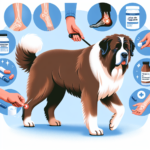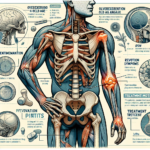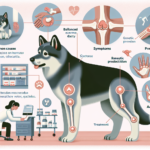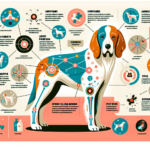Bouvier des Flandres Joint Pain: Causes, Symptoms, Prevention, and Treatment

Introduction
The Bouvier des Flandres is a versatile and robust breed known for its strength, intelligence, and loyalty. Originating from the Flanders region of Belgium and France, this breed was initially developed for herding cattle and pulling carts. Over time, the Bouvier des Flandres has also been utilized in police work, search and rescue, and as a loyal family companion. Characterized by its rugged appearance, dense double coat, and powerful build, the Bouvier des Flandres is a breed that commands attention and respect.
Like many large breeds, the Bouvier des Flandres is prone to certain health issues, with joint pain being a significant concern. Joint health is crucial for maintaining the breed’s mobility and overall quality of life. Understanding the causes, symptoms, prevention, and treatment of joint pain in the Bouvier des Flandres is essential for owners who want to ensure their dogs lead healthy, active lives.
Breed-Specific Joint Pain Risks
Genetic Predisposition
The Bouvier des Flandres is genetically predisposed to several joint-related issues, including hip dysplasia, elbow dysplasia, and arthritis. Hip dysplasia is a condition where the hip joint does not fit properly into the hip socket, leading to pain and mobility issues. Elbow dysplasia involves abnormal development of the elbow joint, causing lameness and discomfort. Arthritis, a degenerative joint disease, can also affect this breed, leading to chronic pain and stiffness.
Age-Related Risks
As the Bouvier des Flandres ages, the risk of developing joint pain increases. Typically, signs of joint issues may start to appear in middle age, around 5 to 7 years old. However, some dogs may show symptoms earlier, especially if they have a genetic predisposition. Senior Bouviers, those over 8 years old, are particularly vulnerable to arthritis and other degenerative joint conditions.
Activity Level and Joint Stress
The Bouvier des Flandres is an active and energetic breed, often engaged in activities such as herding, agility, and obedience training. While regular exercise is essential for their overall health, excessive or high-impact activities can put additional stress on their joints. Owners should be mindful of balancing exercise to prevent overexertion and potential joint damage.
Common Symptoms of Joint Pain in Bouvier des Flandres
General Symptoms
- Limping or favoring one leg
- Stiffness, especially after rest or sleep
- Reluctance to jump, climb stairs, or engage in physical activities
- Decreased activity level or lethargy
- Visible discomfort or pain when touched or moved
- Swelling around the joints
Breed-Specific Symptoms
In the Bouvier des Flandres, joint pain may manifest more prominently due to their size and weight. Owners may notice a pronounced limp or difficulty rising from a lying position. Additionally, Bouviers may become more irritable or less willing to participate in activities they once enjoyed.
When to Consult a Vet
If you observe any of the above symptoms in your Bouvier des Flandres, it is crucial to consult a veterinarian promptly. Early diagnosis and intervention can significantly improve the prognosis and quality of life for dogs suffering from joint pain. Regular veterinary check-ups are also essential for monitoring joint health and catching any issues early.
Preventive Measures for Joint Health
Exercise Recommendations
Regular, moderate exercise is vital for maintaining joint health in the Bouvier des Flandres. Activities such as walking, swimming, and low-impact play are excellent choices. Avoid high-impact exercises like jumping or running on hard surfaces, which can exacerbate joint stress. Consistent, controlled exercise helps keep the muscles strong and supports joint stability.
Dietary Suggestions
A balanced diet rich in essential nutrients is crucial for joint health. Consider incorporating foods or supplements that contain glucosamine, chondroitin, and omega-3 fatty acids, which support joint function and reduce inflammation. High-quality commercial dog foods formulated for large breeds often include these nutrients. Consult your veterinarian for specific dietary recommendations tailored to your dog’s needs.
Weight Management
Maintaining a healthy weight is one of the most effective ways to reduce joint stress in the Bouvier des Flandres. Excess weight puts additional pressure on the joints, exacerbating pain and mobility issues. Regularly monitor your dog’s weight and adjust their diet and exercise routine as needed to keep them within a healthy weight range.
Early Screening and Monitoring
Early screening for joint issues can help catch problems before they become severe. Regular veterinary check-ups should include joint assessments, especially as your Bouvier des Flandres ages. X-rays and other diagnostic tools can help identify conditions like hip or elbow dysplasia early, allowing for timely intervention and management.
Treatment Options for Joint Pain
Non-Surgical Treatments
Non-surgical treatments for joint pain in the Bouvier des Flandres include medications, physical therapy, and lifestyle adjustments. Anti-inflammatory drugs and pain relievers can help manage symptoms, while physical therapy can improve mobility and strengthen muscles. Lifestyle changes, such as providing a comfortable sleeping area and avoiding high-impact activities, can also alleviate joint pain.
Surgical Options
In severe cases, surgical intervention may be necessary to address joint pain. Common surgeries for joint issues in the Bouvier des Flandres include hip replacement, elbow arthroscopy, and joint fusion. These procedures can significantly improve mobility and reduce pain, but they come with risks and require a thorough discussion with your veterinarian.
Alternative Therapies
Alternative treatments like acupuncture, hydrotherapy, and massage can provide additional relief for joint pain. Acupuncture involves inserting thin needles into specific points on the body to reduce pain and inflammation. Hydrotherapy, or water therapy, allows dogs to exercise with minimal joint stress. Massage can help improve circulation and reduce muscle tension around the joints.
Lifestyle and Management Tips
Daily Care Routine
A consistent daily care routine can help manage joint pain in the Bouvier des Flandres. This routine might include gentle exercise, administering medications or supplements, and providing a comfortable resting area. Regular grooming can also help monitor for any changes in mobility or discomfort.
Modifying the Home Environment
Making your home more comfortable for a dog with joint pain can significantly improve their quality of life. Consider using ramps instead of stairs, providing orthopedic beds, and ensuring that food and water bowls are at a comfortable height. Non-slip mats can also help prevent falls and reduce joint strain.
Long-Term Management
Long-term management of joint pain involves ongoing monitoring and adjustments to your dog’s care routine. Regular veterinary check-ups, maintaining a healthy weight, and providing appropriate exercise are crucial. Additionally, staying informed about new treatments and therapies can help you provide the best care for your Bouvier des Flandres.
FAQs About Bouvier des Flandres and Joint Pain
What are the early signs of joint pain in Bouvier des Flandres?
Early signs of joint pain include limping, stiffness, reluctance to move, and visible discomfort when touched or moved. If you notice any of these symptoms, consult your veterinarian promptly.
Can joint pain in Bouvier des Flandres be prevented?
While genetic predispositions cannot be entirely prevented, maintaining a healthy weight, providing regular moderate exercise, and ensuring a balanced diet can significantly reduce the risk of joint pain.
Are there specific exercises that are better for Bouvier des Flandres with joint pain?
Low-impact exercises like walking and swimming are ideal for Bouviers with joint pain. These activities help maintain muscle strength and joint mobility without putting excessive stress on the joints.
What dietary supplements are beneficial for joint health in Bouvier des Flandres?
Supplements containing glucosamine, chondroitin, and omega-3 fatty acids are beneficial for joint health. These nutrients support joint function and reduce inflammation. Always consult your veterinarian before adding supplements to your dog’s diet.
When should I consider surgical options for my Bouvier des Flandres’ joint pain?
Surgical options should be considered when non-surgical treatments are no longer effective, and your dog’s quality of life is significantly impacted. Discuss the potential benefits and risks with your veterinarian to make an informed decision.
Conclusion
Joint pain is a significant concern for the Bouvier des Flandres, but with proper care and attention, it can be managed effectively. Understanding the causes, symptoms, prevention, and treatment options is crucial for ensuring your dog’s joint health. Regular veterinary check-ups, a balanced diet, appropriate exercise, and weight management are key components of maintaining joint health. By taking proactive measures and consulting with your veterinarian, you can help your Bouvier des Flandres lead a happy, active, and pain-free life.




